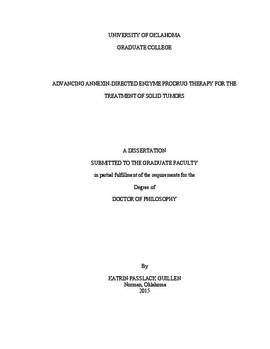| dc.description.abstract | By targeting enzymes to the surface of tumor cells, tumor vasculature, and metastatic lesions, annexin-directed enzyme prodrug therapy aims to create high-dose chemotherapy only in the direct vicinity of the tumor site and therefore mitigate the side effects experienced by healthy tissues. To improve the power and clinical relevance of annexin-directed enzyme prodrug therapy, we aimed to develop and evaluate a new family of fusion proteins centered about the human β-glucuronidase (βG) enzyme. We also intended to provide considerable evidence for the tumor type independence of annexin-directed enzyme prodrug therapy via the evaluation of βG fusion proteins on pancreatic, breast, and colon cancer, as well evaluation of three existing fusion proteins, containing the non-human enzymes L-methioninase, purine nucleoside phosphorylase, and cytosine deaminase on pancreatic and prostate cancer.
When tethered to the tumor cell surface, the enzymes studied are capable of converting relatively harmless prodrugs into potent anti-cancer compounds. For βG we investigated the chemotherapeutic SN-38, which is the preferred first and second line treatment option for colon cancer. In healthy tissue, βG is sequestered within lysosomes, thus posing little risk of prodrug activation by endogenous βG, while allowing for use of the human enzyme, which greatly alleviates any risk of immunogenicity. For the non-human enzymes studied, which carry little risk of endogenous prodrug activation but high risk of immunogenicity, we investigated the toxic compounds methylselenol, 2-flouroadenine, and 5-flourocytosine.
Each enzyme is targeted to the tumor by means of fusion to an annexin A1 or A5 protein, creating a fusion protein. A1 and A5 tightly bind phosphatidylserine, an anionic cell membrane phospholipid, which is strictly segregated to the cytoplasmic leaflet in healthy cells but robustly and consistently translocated to the outer leaflet of tumor cells, their metastases, and tumor vasculature. Phosphatidylserine targeting via annexin is an attractive targeting approach that is highly tumor-specific in comparison to normal tissue, yet retains multi cell-type targeting capabilities once within the tumor microenvironment.
Herein, we present substantial evidence that the mechanism of action of annexin-directed enzyme prodrug therapy is realistically tumor type independent. Additionally, we unveil a novel family of fusion proteins, the most notable of which is an A5-16a3 βG mutant fusion. The annexin-βG fusion proteins are the first of their kind as they enable on-site, combination drug therapy covering a variety of chemotherapeutic strategies, which can be tailored to individual patients’ genotypes simply based on prodrug selection. Not only do these fully human annexin-βG fusion proteins present a powerful approach for the treatment of metastatic disease, but they also promise to be non-immunogenic and are ready for rapid transition to translational work in solid tumors.
Keywords: annexin, phosphatidylserine, vascular targeting, prodrug, β-glucuronidase, colon cancer, pancreatic cancer, breast cancer, prostate cancer | en_US |
